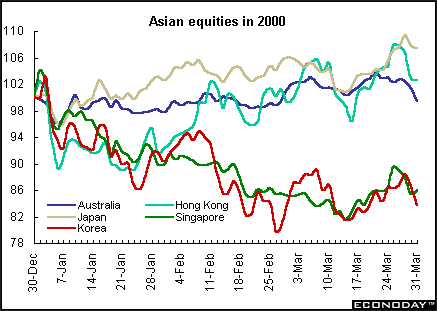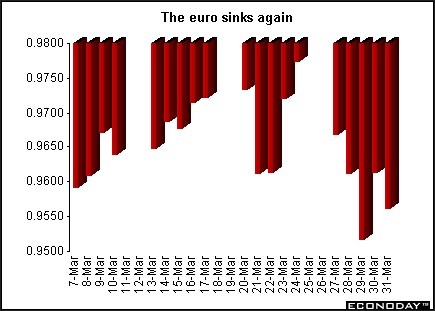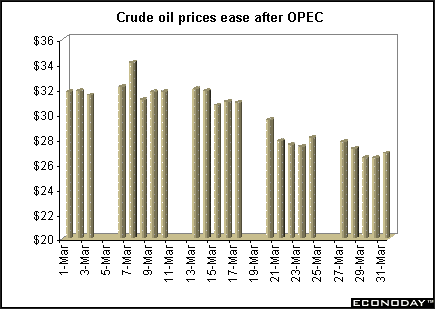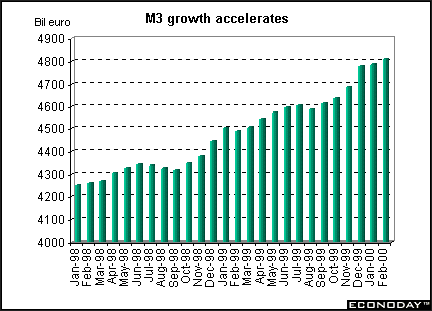| Previous Articles |
|
Old
or new
can't decide
What
a difference a week makes! Europe and Britain Below is a graph depicting first quarter performance of the London FTSE 100, Frankfurt DAX and Paris CAC. While the CAC and DAX finished the quarter above their December 31, 1999 levels, the FTSE sank. If not for the markets' dismal performance last week, the results would have been much better.
As for last week, the markets were dragged down by numerous factors including the squaring of positions for the end of the quarter, first quarter earnings jitters, interest rate worries, and plummeting new economy equities especially on the U.S. Nasdaq. On the week, the FTSE 100 lost 198 points or 2.9 percent to end at 6540. The DAX plummeted 4.4 percent or 348 points even though preliminary settlements with major German unions were deemed to be non-inflationary. The DAX ended the week at 7932. The CAC slipped 1.2 percent or 78 points to end the week at 6364. Asia
Japanese stocks surged to a 40 month high Wednesday on expectations that the critical Tankan Survey to be released today (Monday) would show that the Japanese economy is recovering faster than many think. Despite the leap year effect, the Nikkei rose to 20,706.65, the highest since December 1996. The index rose 28.4 per cent on the year, finishing a fiscal year above 20,000 for the first time since March 1996. After record closes on Monday and Tuesday, the Hong Kong Hang Seng was particularly affected by the Nasdaq's swoon and as a result, plummeted also. The sell off on the Nasdaq along with the Tiger Fund demise hit sentiment. In addition March futures expired on Thursday, eliminating the need for traders with long positions to support the index heavyweights. The Hang Seng dropped 2.13 percent or 378 points to close the week at 17,407. Americas
The Toronto Stock Exchange Composite 300 lurched down 5.8 percent or 590 points after closing at new highs just a week ago. The TSE ended the week at 9462. Note how the TSE parallels the Nasdaq in the graph above. Currencies
euro down, yen up The euro dropped against the dollar on expectations the European Central Bank won't raise interest rates as quickly as the Federal Reserve. There was also renewed recognition that Euroland growth continues to lag the United States. The euro had surged after the Swiss central bank raised its interest rate target band more than expected, fueling talk other European central banks would follow. However, when this did not happen, the euro sank. The drop against the dollar was exacerbated at week's end when the euro dropped below the 100 yen level on Friday.
The yen rose dramatically on Friday as exuberance permeated the currency markets on expectations that the Tankan will show Japanese businesses are more confident about the economy. The yen surged to a record high against the euro and a three month high against the dollar. The yen gained 4 percent against the dollar on the week.
The yen's gains were limited by speculation that some Japanese institutional investors will buy dollars to seek higher returns abroad once the new business year starts on April 1. A rapidly rising yen could derail Japan's economic recovery by hurting profits of Japanese exporters. Central
banks tread water The European Central Bank Governing Council, as expected, decided to leave its main policy making refinance rate unchanged at 3.50 percent. The ECB also left its marginal deposit rate which forms the floor for euro money market rates at 2.50 percent, while the marginal lending rate which forms the ceiling was left unchanged at 4.50 percent. Two weeks ago the ECB raised its refinancing rate by 25 basis points to 3.5 percent, the third increase in less than five months. Since then, oil prices have declined, while Europe's largest union, IG Metall, agreed to a lower than expected wage increment, easing some concerns about inflation. Higher rates can boost the return on deposits denominated in euros. The ECB's 3.5 percent rate compares with the Federal Reserve's federal funds rate of 6 percent and Japan's near zero rates. The Bank of Greek, as expected, left its key 14-day deposit rate unchanged at 9.25 percent at its regular money market operation Wednesday. The Bank of Greece cut its deposit rate by 50 basis points in early March in a widely expected move to bring its key official rate closer to that of the European Central Bank in preparation for entry into European Monetary Union. Greece has submitted its application for entry into monetary union and hopes to join EMU from January 2001. The Bank of Greece is expected to cut rates gradually through 2000 to meet the ECB's refinance rate by the time of Greece's entry into EMU. OPEC returns to pre-1999
production levels
Indicator
scoreboard
February private sector credit growth rate rose 10.5 percent when compared with last year. The ECB had cited the double digit growth rate as one of the reasons for each of its last two rate hikes. Italy February producer prices surged 0.6 percent and 4.6 percent when compared with last year. The index was affected by higher oil import prices and other commodities compounded by a weak euro. The February 4.6 percent rise when compared with last year was the highest since February 1996 when the index rose by 4.9 percent. As in recent months, the strong year on year increase was partly due to a very subdued PPI a year ago when prices were falling. France The seasonally adjusted February unemployment rate fell to 10.2 percent, according to the ILO definition, which excludes job seekers who did any work during the month. Compared to February 1999, when the ILO rate stood at 11.4 percent, unemployment was down 336,000. The latest ILO rate is the lowest since March 1992.
January seasonally and workday adjusted manufacturing output fell 0.3 percent but grew 5.3 percent when compared with last year. Monthly declines for consumer goods and semi-finished goods outweighed further output gains for capital goods and the auto industry. Energy output fell 1.2 percent in January after a 1.7 percent drop in December in part because of the outages caused by the year end storm. February production price index rose 0.7 after a 0.5 percent rise in January, for a gain of 10.7 percent on the year. The acceleration was largely led by energy prices, which rose 2.7 percent in February after a 1.2 percent gain in January. Energy prices were up 51.7 percent on the year in February after they soared 47.6 percent in January. Spain February non-seasonally adjusted producer prices rose 0.8 percent on the month. While PPI energy prices again increased strongly in February, other price categories also showed strong gains. The annual PPI rate rose to 5.1 percent, mainly due to a base effect from very low commodity and oil prices in the same period last year. Britain Fourth quarter gross domestic product remained unrevised at 0.8 percent. When compared with last year, GDP rose 3.0 percent. An upward revision to profits, especially those for financial corporations, helped to lift the final annual growth rate. Fourth quarter household expenditures rose 1.1 percent, though the annual rate at 4.5 percent was still the highest since second quarter 1998. For 1999 as a whole, household expenditures rose by 4.0 percent, with growth driven by household durables, up 10.4 percent. Asia February seasonally adjusted industrial output rose 3.0 percent and 8.4 percent when compared with a year earlier. The increase was attributed mostly to one time leap year effects. Without the extra day in February, output would have been roughly unchanged from the previous month. Shipments rose 0.5 percent on the month and were up 8.6 percent over the previous year. Inventories rose 0.2 percent compared with January but were down 4.5 percent over the same month a year ago. February seasonally adjusted unemployment rate rose to a post war record 4.9 percent from 4.7 percent in January. The labor force participation rate fell to 61.4 from 61.8.
March consumer price index for Tokyo rose by a preliminary and unadjusted 0.2 percent from the previous month but was off 0.7 percent from the previous year. Tokyo's CPI for fiscal 1999 was down an unadjusted 0.6 percent from a year earlier. The February consumer price index for Japan was down 0.1 percent from the previous month, or down 0.6 percent from the previous year. February household spending by wage earner families was up a seasonally adjusted 2.6 and 3.8 percent from a year earlier. Wage earning households account for roughly 60 percent of Japan's total household spending. However, the extra day in February because of leap year helped push up the result. Average income fell a real 0.9 percent on the year. The propensity to consume, or the ratio of household spending to disposable income, rose to 71.5 in February from January's 70.0. South Korea February industrial output slipped an unadjusted 0.9 percent led by lower production of computer chips and vehicles. However it jumped 25.4 percent when compared with last year. March consumer price index rose 0.3 percent and 1.6 percent when compared with a year ago because of a larger than usual increase in school tuition fees. March producer prices rose 2.4 percent when compared with a year earlier. February current account surplus fell to $793.3 million, down from a surplus of $2.09 billion a year ago, because of a sharp drop in the goods surplus. However, February's current account surplus was larger than the January surplus of $316.5 million. The goods balance reached a surplus of $722.8 million in February, sharply down from a surplus of $2.2 billion a year ago due to a surge in imports spurred by rising global oil prices and strong domestic demand. When compared with last year, customs cleared imports surged 58.5 percent while exports grew 29.7 percent. Australia February trade deficit narrowed to 908 million Australian dollars from a A$1.36 billion deficit in January. Exports to Asia rose 16 percent in original terms after a 13 percent fall in January. A stronger world economy and higher commodity prices have boosted exports, helping to narrow the current account deficit. February imports rose 2 percent. February seasonally adjusted retail sales slipped 0.2 percent after a revised drop of 0.7 percent in January. This is the first ever three consecutive month drop since retail sales data were first compiled in 1962. Retail sales are up 3 percent when compared with last year. Americas Some items, specifically motor vehicles, lumber, pulp, newsprint and certain metals, often have their prices quoted in U.S. dollars. Consequently, exchange rate fluctuations affect their contribution to the IPPI. From January to February, the Canadian dollar lost ground, putting upward pressure on the IPPI. If the exchange rate had not changed between the two months, the index would have advanced 0.7 percent instead of 0.9 percent. On a yearly basis, a higher valued Canadian dollar narrowed the increase in the IPPI. If the exchange rate had not changed between February 1999 and February 2000, the index would have risen 6.5 percent.
February raw material prices increased 3.2 percent. If mineral fuels had been excluded, the increase would have been just 0.6 percent. Crude oil prices rose 7.9 percent on the month. Manufacturers paid 37.1 percent more for raw materials than they did a year earlier, the strongest increase since the raw materials price index began in 1981. Surging oil prices were responsible. If the mineral fuels component almost all of which is crude oil were excluded, raw material prices would have risen only 7.2 percent. Crude oil prices have increased more than 2.5 times ( up 153.4 percent) since February 1999. January gross domestic product at factor cost (GDP) jumped 0.5 percent and 4.7 percent when compared with last year on strong domestic and foreign demand. It was the 18th consecutive monthly increase, representing the longest unbroken string of gains since 1961, when measurement of monthly GDP first began. Nearly all sectors of the economy contributed to January's advance. Total factory output rose 0.7 percent in January, as higher production of automotive products, fabricated metal, and wood products offset declines in the primary metal, electronic goods and food industries. Overall, 14 of 22 major industry groups, accounting for 54.6 percent of total manufacturing production, advanced in January. BOTTOM
LINE Looking Ahead: April
3 through April 7, 2000
|
||||||||||||||||||||||||||||||||||||||||||||||||||||||||||||||||||||||||||||||||||||||||||||||||||||||||||||||||||||||||||||||||||||||||||||||||||||||||||||||||||||||||||||||||||||||||||||||||||||||||||||||









